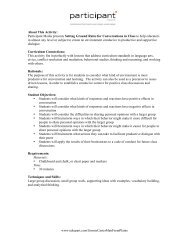THE KITE RUNNER COMPANION CURRICULUM - TakePart
THE KITE RUNNER COMPANION CURRICULUM - TakePart
THE KITE RUNNER COMPANION CURRICULUM - TakePart
You also want an ePaper? Increase the reach of your titles
YUMPU automatically turns print PDFs into web optimized ePapers that Google loves.
HANDOUT 2.2<br />
HISTORICAL OVERVIEW OF AFGHANISTAN<br />
TIMELINE:<br />
AFGHANISTAN<br />
A CHRONOLOGY<br />
OF KEY EVENTS<br />
1919 - Afghanistan regains independence after third war against British forces trying to<br />
bring country under their sphere of influence.<br />
1926 - Amanullah proclaims himself king and attempts to introduce social reforms<br />
leading to opposition from conservative forces.<br />
1929 - Amanullah flees after civil unrest over his reforms.<br />
1933 - Zahir Shah becomes king and Afghanistan remains a monarchy for next four<br />
decades.<br />
1953 - General Mohammed Daud becomes prime minister. Turns to Soviet Union for<br />
economic and military assistance. Introduces a number of social reforms, such as<br />
abolition of purdah (practice of secluding women from public view).<br />
1963 - Mohammed Daud forced to resign as prime minister.<br />
1964 - Constitutional monarchy introduced - but leads to political polarisation and power<br />
struggles.<br />
1973 - Mohammed Daud seizes power in a coup and declares a republic. Tries to play<br />
off USSR against Western powers. His style alienates left-wing factions who join forces<br />
against him.<br />
1978 - General Daud is overthrown and killed in a coup by leftist People’s Democratic<br />
Party. But party’s Khalq and Parcham factions fall out, leading to purging or exile of<br />
most Parcham leaders. At the same time, conservative Islamic and ethnic leaders who<br />
objected to social changes begin armed revolt in countryside.<br />
1979 - Power struggle between leftist leaders Hafizullah Amin and Nur Mohammed Taraki<br />
in Kabul won by Amin. Revolts in countryside continue and Afghan army faces collapse.<br />
Soviet Union finally sends in troops to help remove Amin, who is executed.<br />
Soviet intervention<br />
1980 - Babrak Karmal, leader of the People’s Democratic Party Parcham faction, is<br />
installed as ruler, backed by Soviet troops. But anti-regime resistance intensifies with<br />
various mujahedin groups fighting Soviet forces. US, Pakistan, China, Iran and Saudi<br />
Arabia supply money and arms.<br />
1985 - Mujahedin come together in Pakistan to form alliance against Soviet forces. Half<br />
of Afghan population now estimated to be displaced by war, with many fleeing to neighbouring<br />
Iran or Pakistan. New Soviet leader Mikhail Gorbachev says he will withdraw<br />
troops from Afghanistan.<br />
1986 - US begins supplying mujahedin with Stinger missiles, enabling them to shoot<br />
down Soviet helicopter gunships. Babrak Karmal replaced by Najibullah as head of<br />
Soviet-backed regime.<br />
1988 - Afghanistan, USSR, the US and Pakistan sign peace accords and Soviet Union<br />
begins pulling out troops.<br />
1989 - Last Soviet troops leave, but civil war continues as mujahedin push to overthrow<br />
Najibullah.<br />
1991 - US and USSR agree to end military aid to both sides. Mujahedin triumph<br />
1992 - Resistance closes in on Kabul and Najibullah falls from power. Rival militias vie<br />
for influence.<br />
1993 - Mujahideen factions agree on formation of a government with ethnic Tajik,<br />
Burhanuddin Rabbani, proclaimed president.<br />
1994 - Factional contests continue and the Pashtun-dominated Taliban emerge as major<br />
challenge to the Rabbani government.<br />
24<br />
APPENDIX 2









